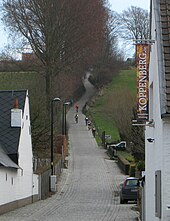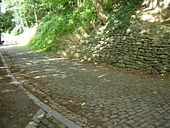Tour of flanders
The Tour of Flanders (officially De Ronde van Vlaanderen) is a one-day professional road cycling race held in the Flanders region in Belgium. Currently, it covers a journey from the province of Antwerp, specifically from its namesake city, to the Flemish Ardennes, south of East Flanders, where the characteristic attractions of the race are found. It is held on the first Sunday of April and belongs to the UCI WorldTour calendar, the highest category of professional racing.
The Tour of Flanders was created in 1913. Since then, it has only been interrupted from 1915 to 1918 by the First World War. In fact, it is the only classic that was performed on German territory during World War II.
It is the second and youngest of the five monuments of cycling (Milan-San Remo, Paris-Roubaix, Liège-Bastogne-Liège and Giro Lombardy) and is the last and most important race of the so-called " flamenco cycling week" (Through Flanders, E3 Harelbeke, Ghent-Gevelgem and Three Days of La Panne). It is also the last Belgian pavé race on the UCI WorldTour calendar and is part of the so-called "Classics of Flanders".
The hallmarks of De Ronde are its long mileage (260 km) and its pavé “walls”, very hard as they are cobbled and almost always have strong ramps, which during the route alternate with asphalted levels and sectors of flat pavé, although not as complicated as those of Paris-Roubaix.
With three wins, six cyclists hold the record for victories in the event: Achiel Buysse (1940, 1941 and 1943), Fiorenzo Magni (1949, 1950 and 1951), Eric Leman (1970, 1972 and 1973), Johan Museeuw (1993, 1995 and 1998), Tom Boonen (2005, 2006 and 2012) and Fabian Cancellara (2010, 2013 and 2014).
It is organized by Flanders Classics and since 2004 the race has had a women's version (officially Ronde van Vlaanderen voor vrouwen).
History
Like other major cycling events, such as the Tour de France or Paris-Roubaix, the Tour of Flanders arose from the idea of promoting a Flemish sports newspaper, the Sportwereld.
The sports newspaper Sportwereld was born in the summer of 1912, shortly after the first victory of a Belgian, Odile Defraye, in the Tour de France. The newspaper, financed by August De Maeght, had the objective of reporting on the sport and promoting the use of Dutch, an officially recognized language (along with French) in Belgium a few years ago, in 1898.
Leon Van de Haute and Karel Van Wijnendaele, the editors of the magazine, quickly decided to follow the lead of foreign sports dailies by establishing a race to consolidate their title's status, looking particularly to Roubaix as an example. In February 1913 they announced the plans for the Tour of Flanders, announcing that the first edition would take place in May of that same year.
The route of the inauguration Ronde Van Vlaanderen, starting and finishing in Ghent, stretched 324 kilometers, encircling the Dutch-speaking provinces of East and West Flanders and passing through all the major cities because, as he wrote Van Wijnendaele, "all Flemish cities had to contribute to the emancipation of the Flemings".
The first edition (March 25, 1913) of De Ronde was characterized by its lack of hills, a peculiarity for which it is distinguished today. A total of 36 Belgians and 1 Frenchman participated in the opening of the race. The winner, Paul Deman, completed the course in just over 12 hours.
In the third edition, which took place in 1919, a few months after the end of World War I, the Ronde gained its first hills, in the form of the cobbled climbs of Tiegemberg and Kwaremont. In 1928 the Kruisberg was added to the route. These three hills, apart from a single occurrence of the Edalareberg, were the only climbs on Ronde's course until the post-war era.
In 1938, the daily Het Nieuwsblad bought Sportwereld. Years later, in 1945, one of the rival sports papers, Het Volk, set up a one-day eponymous race in preparation for De Ronde. That same year the Sporting Club Kuurne also founded a classic, the Kuurne-Brussels-Kuurne, which initially took place in June but in 1949 moved to the same weekend as Het Volk to still create more incentive to the stage prior to the Tour of Flanders.
In 1950, Van Wijnendaele added the Muur in Geraardsbergen to the three "hills" of the route.
Tour
The specific heights and the finish line have varied greatly throughout the history of the men's professional event, being the most changing route of the cycling monuments along with that of the Giro de Lombardy. In fact, the walls that have been climbed in recent years were not released until at least the 1950s and most of them after the 1970s, such as Oude Kwaremont and Koppenberg, uploaded for the first time in 1974 and 1976, respectively. As for the arrival, he alternated for a long time between the city of Ghent and several nearby towns, such as Mariakerke (Ghent district), Evergem and especially Wetteren, until in 1973 he settled in Meerbeke (Ninove district) and since 2010 in the same Ninove. The beginning of the race has not suffered many variations, with only 3 changes: Ghent as the start until 1976, Sint-Niklaas from 1977 to 1997 and Bruges since 1998.
After several editions with routes with similar characteristics, with some changes in the intermediate layout (such as the inclusion or not of the Koppenberg, or the inward turn of 2011) but keeping the same start, finish and Muur-Kapelmuur and Bosberg as final heights Take as an example the heights climbed in the 2011 edition:
| Difficulties of the 2011 tour: | |||||
|---|---|---|---|---|---|
| Number | Name | Km | Pavemento | Length (m) | Average Earring |
| 1 | Kluisberg | 99 | asphalt | 1250 | 5.3 per cent |
| 2 | Nokereberg | 118 | pavé | 375 | 5.9 per cent |
| 3 | Molenberg | 157 | pavé /asfalto | 463 | 7% |
| 4 | Wolvenberg | 167. | asphalt | 645 | 7.9% |
| 5 | Oude Kwaremont | 185. | pavé /asfalto | 2200 | 4% |
| 6 | Paterberg | 189 | pavé | 360 | 12.9 per cent |
| 7 | Koppenberg | 195 | pavé | 600 | 11.6% |
| 8 | Steenbeekdries | 200 | pavé | 700 | 5.3 per cent |
| 9 | Taaienberg | 203 | pavé | 530 | 6.6% |
| 10 | Berg Ter Stene | 213 | asphalt | 1.300 | 5% |
| 11 | Leberg | 216 | asphalt | 950 | 4.2% |
| 12 | Berendries | 222 | asphalt | 940 | 7% |
| 13 | Valkenberg | 227 | asphalt | 540 | 8.1 per cent |
| 14 | Tennis | 233 | asphalt | 455 | 6.4% |
| 15 | Eikenmolen | 239 | asphalt | 610 | 5.9 per cent |
| 16 | Muur-Kapelmuur | 249 | pavé | 475 | 9.3% |
| 17 | Bosberg | 252 | pavé/asfalto | 980 | 5.8 per cent |
In September 2011 it was announced that the 2012 Tour of Flanders would not end in Meerbeke (Ninove), the end of the event since 1973, but would end in Oudenaarde, with the collateral effect of the suppression of the Muur-Kapelmuur and the Bosberg, the two previous climbs to the finish line in Ninove, becoming the last climbs at Kwaremont and Paterberg, which were faced 3 times during the final 80 km by completing several loops south of the town of Oudenaarde. Take an example the heights climbed in the 2012 edition:
| Difficulties of the 2012 tour: | |||||
|---|---|---|---|---|---|
| Number | Name | Km | Type | Length (m) | Average Earring |
| 1 | Taaienberg | 119.3 | pavé | 530 | 6.6% |
| 2 | Eikenberg | 115.7 | pavé/asfalto | 350 | 5.7 per cent |
| 3 | Molenberg | 131.3 | pavé/asfalto | 463 | 7% |
| 4 | Rekelberg | 145.7 | asphalt | 800 | 4% |
| 5 | Berendries | 149 | asphalt | 940 | 7% |
| 6 | Valkenberg | 156.8 | asphalt | 540 | 8.1 per cent |
| 7 | Oude-Kwaremont | 179,5 | pavé/asfalto | 2200 | 4% |
| 8 | Paterberg | 183 | pavé | 360 | 12.9 per cent |
| 9 | Koppenberg | 189.6 | pavé | 600 | 11.6% |
| 10 | Steenbeekdries | 194,9 | asphalt | 700 | 5.3 per cent |
| 11 | Kruisberg/Hotond | 210.1 | asphalt | 2500 | 5% |
| 12 | Oude-Kwaremont | 220 | pavé/asfalto | 2200 | 4% |
| 13 | Paterberg | 223.4 | pavé | 360 | 12.9 per cent |
| 14 | Hoogberg/Hotond | 230.4 | asphalt | 3,000 | 3.5% |
| 15 | Oude-Kwaremont | 240.2 | pavé | 2200 | 4% |
| 16 | Paterberg | 243.6 | pavé | 360 | 12.9 per cent |
Since 2012, it has undergone small changes over the years. In 2017, the Kapelmuur would return to the tour, although far from the finish line.
Tour of Flanders sub-23
Since 1996, the Tour of Flanders under-23 (officially and in Dutch: Ronde van Vlaanderen Beloften) has also been held, which is a Tour of Flanders limited to under-23 riders, one week after its namesake without age limitation.
Its first editions were amateur until the creation of the UCI Continental Circuits in 2005 when it began to form part of the UCI Europe Tour, the first two years in category 1.2 (last category of professionalism), then in the specific category created in 2007 for sub-23 runners, within the last category of professionalism: 2.1U; and since 2008 in the category created in 2007, also within the last category of professionalism: 2.Ncup (UCI Nations Cup).
It has between 160 and 175 km in its layout, about 100 km less than its namesake without age limitation, although with similar characteristics.
Honours of Prizes
Note: The third position obtained by George Hincapie in the 2006 Tour of Flanders, was declared void after the suspension given by the UCI to the cyclist in the framework of the doping case against Lance Armstrong
Human awards by country
Until the 2022 edition.
Note: The third position obtained by George Hincapie in the 2006 Tour of Flanders, was declared void after the suspension given by the UCI to the cyclist in the framework of the doping case against Lance Armstrong
Statistics
Most wins
Until the 2022 edition.
Consecutive wins
- Two victories in a row:
More podiums
Johan Museeuw, nicknamed the Lion of Flanders, and Alberic Schotte are the cyclists with the most podium finishes in the race.
Until the 2021 edition.
Other information
- The longest edition was played in 1913: 324 km
- The slowest edition was played in 1923: 26,233 km/h
 Henri Suter.
Henri Suter. - The fastest edition took place in 2001: 43,580 km/h
 Gianluca Bortolami.
Gianluca Bortolami. - Youngest racer to win: Rik Van Steenbergen in 1944 (19 years, 6 months and 23 days).
- Senior winner: Andrei Tchmil in 2000 (37 years, 2 months and 11 days).
- The record of participation is by George Hincapie. He finished the race 17 times.
- Watchful world champions winners of the Flander Tour: Louison Bobet (1955), Rik Van Looy (1962), Eddy Merckx (1975), Tom Boonen (2006) and Peter Sagan (2016).
Contenido relacionado
Athens 2004 Olympic Games
Annex:Swimming at the 2004 Summer Olympics - Women's 100m butterfly
Hockenheim





